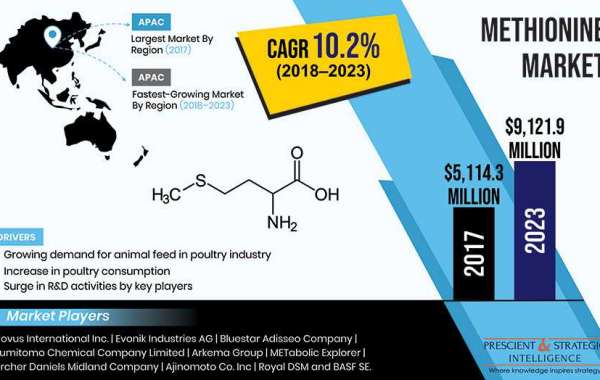In 2017, the global methionine market generated a revenue of $5,114.3 million and is expected to attain $9,121.9 million in 2023, advancing at a 10.2% CAGR during the forecast period (2018–2023). The market is growing due to the rise in research development (RD) activities by key players, increasing requirement for animal feed in the poultry industry, and surging poultry consumption. Methionine is a vital amino acid which cannot be biosynthesized by the human body and is thus taken externally. Based on form, the market is divided into liquid and powder methionine.
When type is taken into consideration, the methionine market is categorized into methionine hydroxy analog (MHA), DL-methionine, and L-methionine. Out of these, the DL-methionine category dominated the market during the historical period (2013–2017), holding more than 55.0% and 60.0% shares, in terms of value and volume respectively, in 2017. This is because of the extensive applications of this type in different applications, such as animal husbandry, food processing, and pharmaceutical. The MHA category is expected to grow at the fastest pace during the forecast period.
Get a sample copy of the market report at: http://bit.ly/2PJ7Hew
In terms of application, the methionine market is divided into aquaculture, animal feed additives, food processing, pharmaceuticals, and others (which include personal care and cosmetics). Among these, the animal feed additive division dominated the market during the historical period, contributing more than 60.0% and 70.0%, in terms of value and volume respectively, in 2017. This is ascribed to the surging consumption of meat around the world, which is prompting farmers to utilize methionine in animal diet. The aquaculture division is projected to advance at the fastest pace during the forecast period.
The rising poultry consumption is a key driving factor of the methionine market. This surge in the consumption of poultry is occurring due to the increasing disposable income of people, rising population, changing dietary preferences, and low chicken prices as compared to the prices of other meats. According to the global poultry trend data, the poultry meat uptake is predicted to rise by 1.7 kg per person, from 13.2 kg in 2013 to 14.9 kg in 2023. With this rising consumption of poultry, the requirement for animal feed additive is also rising.
The increasing requirement for methionine in pharmaceutical applications, because of methionine’s therapeutic advantage, is opening up wide opportunities for the players operating in the methionine market. Methionine is extensively being utilized as an intermediate in the preparation of liver-related and vitamins medicines for treating pneumonia, liver cirrhosis, and toxic hepatitis. The acid is further used for helping in the treatment of asthma, Parkinson’s disease, wound healing, allergies, and copper poisoning. In addition to this, L-methionine is a powerful antioxidants and aids in slowing down the aging process.
A key trend being witnessed in the methionine market is the shift towards bio-methionine from synthetic sources. Methionine is primarily derived from petrochemical sources and is utilized as an animal nutritional-feed additive. However, the raw materials used for the synthesis of this acid, such as carbon disulphide, mercaptan, and hydrogen cyanide, are hazardous and hard-to-handle. Attributed to this, biochemical methods of procuring this acid are being researched and implemented. Thus, the rising demand for these bio-based materials, due to their sustainability, is expected to drive the market in the coming years.
Hence, the market is being driven by the surging consumption of poultry around the globe.








